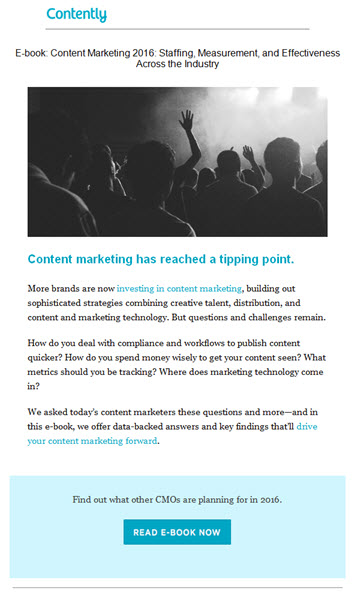According to a recent report, “The Content Marketing Paradox,” content marketing output increased by 35 percent in 2015, while engagement dropped 17 percent. The author of the report, digital marketing solutions provider TrackMaven, theorized that the primary reason for the discrepancy is that there’s a “limit to how much content can be consumed, liked, shared, etc.”
They may be correct. However, I think there are two other, more significant reasons why so much content marketing gets ignored:
1. As pressure mounts on marketers to produce more and more content, the quality of that content begins to suffer. Put more bluntly, a lot of marketing content is complete drivel.
2. Many B2B marketers still haven’t learned how to promote marketing content effectively.
For a prime example of #2, see the email below from (caution: irony ahead) Contently, developers of a content-marketing platform. The ebook on offer could well provide insights and information of value, but from this email, you’d never know it. What lessons can we learn from Contently’s misfire?
 1. Title your content to drive engagement. “Content Marketing 2016: Staffing, Measurement and Effectiveness Across the Industry” may describe the content but it doesn’t communicate uniqueness or information that’s anything more than a broad summary. A title should sell the content, even without any other descriptive copy. (Incidentally, which “industry” are we talking about?)
1. Title your content to drive engagement. “Content Marketing 2016: Staffing, Measurement and Effectiveness Across the Industry” may describe the content but it doesn’t communicate uniqueness or information that’s anything more than a broad summary. A title should sell the content, even without any other descriptive copy. (Incidentally, which “industry” are we talking about?)
2. Communicate the learning value of your content. Audiences engage with content from which they expect to learn something. In promoting content, it’s critical to describe the asset in terms that communicate what and how someone will learn, gain, or understand from the information presented.
In Contently’s email, there’s really nothing that specifically communicates that value. The headline “Content marketing has reached a tipping point” is a point of view, but it tells me nothing about why I should respond or even read further.
The first paragraph is, similarly, a statement of fact, and moreover (“More brands are now investing in content marketing”), something most readers already know. The next paragraph is a list of questions, but does the content on offer address those questions? You might say that’s implied, but mere implication doesn’t drive engagement.
3. Make the content real and tangible. It may sound ridiculously old-fashioned, but the simple act of including an image of the content itself – a thumbnail of the cover, or even an interior page – makes the offer more real, more tangible. Here, the only image is, curiously, what appears to be a concert scene. The connection with content marketing is lost on me, but it certainly does nothing to communicate value or why I should respond.
4. Last and not least, ask people to engage. In the Contently email, there are two text links within the body text, but it’s not at all clear that those links lead to the content on offer. The only real “call to action” is the button at the bottom of the email. If you’re going to include multiple calls to action throughout your email (a best practice), then text links should either be a specific reference to the content (the title of the ebook itself, or a phrase such as “new ebook from the content marketing experts at Contently”) or it should be action-oriented, such as “download the ebook now.”
Want more people to engage with your content? Sure, actually writing great content is Step One. But even great content doesn’t necessarily sell itself. Successful promotion requires communicating the unique, compelling value of your content at every opportunity.
